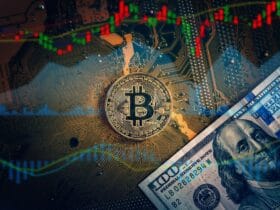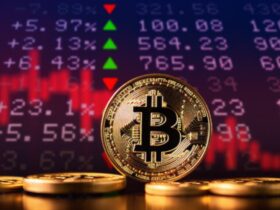Gold, historically, has been considered a countertrend refuge asset.
Bitcoin is still perceived as a “risky” asset, although the “digital gold” narrative is growing.
The bullish movements that bitcoin (BTC) and gold have had in recent weeks have been positive for investors. However, there are doubts about whether these movements are simply part of the speculative nature of both assets or if, behind all this scene, there is a whole economic cloud approaching.
In the last month, bitcoin rose 14%, going from $110,000 to all-time highs of $126,900, reached at the beginning of this week, and then corrected. Meanwhile, gold has increased 12.5% in the same period, going from USD 3,400 on average per ounce to the current USD 4,000, a price never seen before in the history of the metallic asset.
The increase in the performance of both assets during the last 30 days can be better seen in the following TradingView graph:


This increase has been driven by similar macroeconomic forces. Among them, growing financial uncertainty, expectations for more interest rate cuts in the United States, and growing demand for safe havens. against the weakening of the US dollar.
In the case of gold, concerns about inflation, the high level of US public debt and geopolitical tensions have led investors to seek safety in tangible assets, causing its price to rise to record levels.
For bitcoin, increased institutional flow (e.g. through exchange-traded funds or corporate treasuries), the narrative of protection against monetary depreciation, and abundant liquidity They have also served as catalysts for new price peaks.
Now, analysts warn that the increase in gold, in itself, goes beyond speculative issues. Actually, everything indicates that difficult times are approaching marked by growing inflation and monetary deterioration that, as usual, will end up affecting the pockets of the inhabitants.
Benjamin Picton, senior market strategist at Rabobank, is one of those consider that the increase in the price of the precious metal “is sending a signal” that the general inflation of the economy “is already underway.” Argues that central banks are buying gold precisely to avoid being hit by the imminent crisis.
something similar think analyst Bob Czeschin, who thinks that, in current times, Gold is acting like it did in the 1970swhen the metal reached records driven by a series of macroeconomic and geopolitical factors that triggered the appreciation of the ancient asset.
According to Czeschin, just like those years, “we now have a geopolitical crisis, a falling dollar and stubborn inflation.” “And they are all driving gold to new inflation-adjusted record highs,” he notes.
Gold went from about $108 (in 1976) to $850 (in January 1980). That’s an increase of almost 8 times. Compare that to the current rally, which began in post-pandemic panic in late 2022 (to around $1,650). Now, gold is at $4,000 and has traded as high as $3,770, which is a gain of 142%.
Bob Czeschin, financial analyst.
Daniel Arráez, a Venezuelan economist specialized in bitcoin and cryptocurrencies, also agrees with that vision. In dialogue with CriptoNoticias, remember that There are currently different war scenarios underway in various parts of the worldsuch as the Middle East, Ukraine and the Caribbean, which increases geopolitical fear.
Added to this is the poor performance of the US dollar, which has depreciated by 10% so far this year. The dollar index (DXY), which measures the greenback against a basket of 6 currencies, such as the euro, yuan and yen, It went from 109 points in January 2025 to the current 99 pointsas seen in this graph:


As Arráez sees it, the above is a consequence of the fact that, in recent years, The United States “has printed monetary mass in an insane amount”causing loss of purchasing power of its currency.
The latter is reflected in the US money supply, which is currently around 22.2 trillion dollars, 1 trillion more than a year ago, as seen in the following graph:


Such an increase in the US monetary supply suggests that “the purchasing power of the dollar is being diluted,” in Arráez’s opinion. “What 20 years ago a USD 1 bought, it certainly doesn’t buy today,” he adds.
This is not the first time that warnings of an imminent crisis have been made in the US and globally. Henrik Zeberg, a financial analyst, said in June that the global economy embodies the Titanic, and right now, already hit the iceberg and its galleries are flooding. As you see it, “we are clearly in the final phase of the cycle” and, therefore, the global recession is very close.
Bitcoin, digital gold
In this order of ideas, and in the face of the imminent crisis that seems to be approaching, the narrative of bitcoin is born as a digital gold that, like the precious metal, It can contribute as a strong and lasting shelter.
Czeschin believes that BTC is driven “by the same macroeconomic forces” and that, while gold may be the easiest escape route for central banks“this is not the 1970s.”
This narrative is opposed by Zeberg, who is chief economist at the firm SwissBlock. He, although he supports BTC, does not believe that it is a true haven of value due to the intrinsic volatility of the asset. In fact, he believes that BTC could depreciate by up to 95% after reaching a ceiling in the current bullish cycle, which would generate deep damage to the finances of those who have invested in it.
Arráez, for his part, maintains that bitcoin can be a store of value in times of crisisbut “it is only used for the purpose for which it was created, which is to be an alternative to money guarded by a third party, by an authority figure, a control figure.”
The economist comments that bitcoin, despite the fact that it has had major corrections in the past, “is still a very good asset, which has worked perfectly as a reserve of value and time has only reaffirmed this.”


The above brings to light the idea that bitcoin and gold, instead of competing to be the largest reserve asset, are “riding together.” According to the market analysis firm Ecoinometrics, unlike a couple of years ago, currently appreciate a growing demand for “hard assets” and not the preference for any of them.
“If we are entering a broader hard asset bull market, then bitcoin is not only replacing gold, it is participating in a structural expansion. And that opens new bullish potential for the long-term valuation of BTC,” say the analysts at that research company.
Arráez supports that vision. Explain that Gold will continue to be a store of value for investors“but they still don’t understand how far bitcoin can go.”
«I personally consider that BTC constitutes a better deposit, a better store of value than gold could be. And it’s a matter of waiting and seeing where we go with this,” he concluded.






Leave a Reply